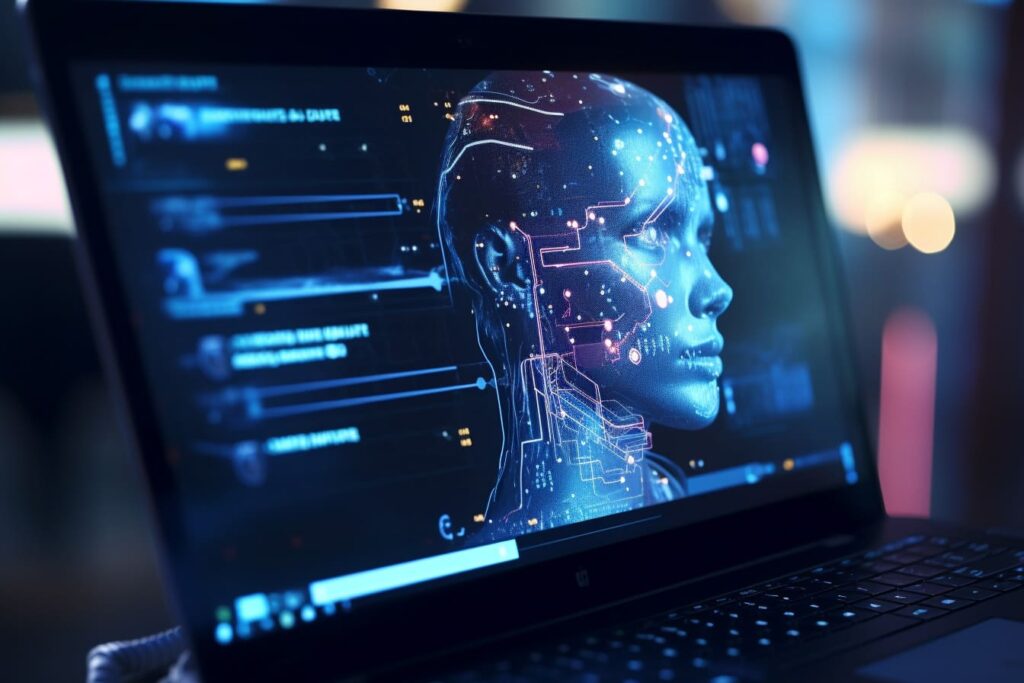Welcome to the AI-Powered Workplace
Imagine walking into the office, coffee in hand, ready to tackle the day’s challenges—except now, you’ve got an AI sidekick. It drafts emails, summarizes meetings, and even helps you brainstorm your next big idea. Sounds great, right?
But here’s the catch: AI can be a game-changer or a chaotic mess, depending on how you use it. Ask it correctly, and it’s like having an ultra-efficient assistant who never takes a lunch break. Use it recklessly, and you might end up with a meeting summary with a fictional promotion you wish you got.
So how do you harness the power of chat-based Large Language Models (LLMs) like ChatGPT, Claude, and Gemini without causing an office-wide meltdown? Whether you’re automating workflows, enhancing creativity, or just trying to avoid AI-induced embarrassment, this guide will walk you through best practices for using LLMs at work—responsibly, securely, and with just the right amount of AI magic.
1️⃣ Understanding Chat-Based LLMs in a Work Environment
What Are Chat-Based LLMs, and Why Should You Care?
Chat-based LLMs are AI-powered text generators that can process, summarize, and create human-like responses. They’re trained on massive amounts of text, allowing them to assist with everything from customer service chats to rewriting that email five times until it sounds perfect.
Think of them as highly advanced interns—capable of incredible things but still needing oversight to avoid embarrassing mistakes.

How AI Supercharges Productivity
Used wisely, LLMs can save hours of work by:
✅ Automating mundane tasks – Drafting reports, responding to FAQs, generating meeting notes.
✅ Enhancing research – Summarizing industry reports, pulling relevant case studies (BrainChat).
✅ Powering creativity – Brainstorming marketing campaigns, refining blog posts, generating code snippets.
But AI isn’t just about efficiency—it’s also about making work more enjoyable. Offloading repetitive tasks lets humans focus on big ideas, problem-solving, and strategy instead of slogging through the same email 20 times.
The Risks: Why AI Still Needs a Human Touch
Of course, LLMs aren’t perfect. Here’s why you can’t just “set it and forget it”:
⚠️ Hallucinations happen – AI really wants to sound confident, even when it’s making things up. Always fact-check (Coveo).
⚠️ Security concerns – Feeding AI confidential data is like whispering secrets to a parrot—you don’t know where they’ll end up (Nucleoo).
⚠️ Bias is baked in – LLMs learn from existing data, meaning they can reflect societal biases unless carefully managed (Forbes).
Using AI effectively at work isn’t just about knowing what it can do—it’s about knowing when and how to use it responsibly.
2️⃣ Setting Up AI for Optimal Workplace Use
Choosing the Right AI Tool for the Job
Not all LLMs are created equal. The best tool depends on what you actually need it for:
| AI Chat Tool | Best For | Limitations |
|---|---|---|
| ChatGPT (OpenAI) | Writing, brainstorming, general productivity | Prone to making up information (TechTarget) |
| Claude (Anthropic) | Business-friendly, thoughtful responses | Slower, stricter content filters |
| Gemini (Google) | Research-heavy tasks, integrates with Google tools | Privacy concerns, inconsistent performance |
| Copilot (Microsoft) | Enterprise-grade AI, integrates with Office apps | Requires Microsoft ecosystem |
Pro tip: If your workplace is serious about AI adoption, consider enterprise-level LLMs with data privacy controls and compliance features. Tools like OpenAI’s business-tier ChatGPT or Microsoft’s Copilot come with added security features designed for sensitive workplace environments.

Keeping AI Use Secure and Compliant
Before you go asking ChatGPT to rewrite your company’s annual report, let’s talk security. Many workplaces still don’t have clear guidelines on AI usage, and that’s a problem (Torys).
🔐 Data Privacy 101: Never input sensitive company data, trade secrets, or personal information into public AI tools. Even though platforms promise security, some data may still be used for training (Krista AI).
✅ Use AI with company-approved tools – Some organizations have dedicated AI platforms with stricter privacy settings.
✅ Train employees on AI security – If your team doesn’t know the risks, they will make mistakes.
✅ Monitor AI-generated content – Make sure nothing confidential (or wildly inaccurate) slips through.
Customizing AI for Your Business Needs
Want AI that understands your industry, brand voice, and unique workflows? Then you need customization:
🚀 Fine-tuning – Some LLMs allow organizations to train AI models on internal data to improve relevance and accuracy (Google Cloud).
⚡ Integrations – AI works best when plugged into existing tools (Slack, Notion, CRM platforms) instead of living in a separate tab.
🛠 Role-Specific Use Cases – AI in HR looks different from AI in sales. Customize responses based on department needs.
Example: A legal team might use AI to summarize case law, while a marketing team leverages it for content brainstorming. Same tool, totally different applications.
What’s Next?
We’ve covered the basics—what AI can do, what it can’t, and how to keep it from accidentally leaking your company’s secrets. But now comes the fun part: getting the most out of it.
In the next sections, we’ll dive into how to structure AI interactions for the best responses, avoid common pitfalls, and use AI as a true workplace superpower.
Ready to level up your AI game? Let’s go. 🚀
3️⃣ Structuring AI Interactions for Maximum Efficiency
Mastering Prompt Engineering: Getting AI to Work for You
Ever feel like AI gives you the right answer—but not quite in the way you need? That’s because prompt engineering is an art form. The clearer and more structured your request, the better the response. Here’s how to craft prompts like a pro:
✅ Be specific – Instead of saying, “Summarize this report,” try, “Summarize this report in three bullet points, highlighting key takeaways for executives.”
✅ Provide context – AI isn’t a mind reader (yet). If you need it to match a specific tone or industry jargon, tell it upfront.
✅ Use step-by-step instructions – Break down complex tasks. Instead of, “Generate a marketing plan,” say, “Create a 3-month social media marketing plan targeting Gen Z consumers, including content themes and sample posts.”
Want more AI-prompting hacks? Check out this guide on crafting effective AI prompts.

Structuring AI Workflows for Maximum Productivity
AI isn’t just a fancy chatbot—it’s a workflow supercharger. Here’s how to integrate it seamlessly into daily tasks:
🔹 For Content Creation: Start with a rough draft from AI, then refine it with human edits.
🔹 For Email & Communication: Use AI to draft messages, but always tweak for personal touch.
🔹 For Research: Have AI summarize articles, then cross-check key facts.
🔹 For Coding: Use AI as a debugging assistant, but don’t rely on it for mission-critical code.
A study by Dialzara found that structured AI workflows reduce manual workload by up to 40%. That’s a lot of reclaimed time.
AI as a Brainstorming Partner
Let’s be real—sometimes, coming up with fresh ideas is the hardest part of work. AI can be a fantastic idea generator, helping you:
💡 Break creative blocks – Stuck on a project? Ask AI for 10 different approaches.
💡 Test new perspectives – Need fresh marketing angles? Get AI to suggest unconventional takes.
💡 Refine your strategy – Provide AI with past data and let it suggest optimizations.
However, AI isn’t a replacement for human intuition. Always review and refine suggestions before running with them.
Knowing When to Rely on AI—and When Not To
While AI is great for speeding up tasks, it’s not infallible. Here’s when you should pause and take over manually:
⚠️ Decision-Making: AI can provide insights, but big business calls still need a human touch.
⚠️ Legal & Compliance Matters: AI doesn’t understand legal nuance. Always double-check with an expert.
⚠️ High-Stakes Communication: AI-written messages can lack emotional nuance—so proofread before sending sensitive emails.
The best AI users aren’t the ones who use it the most—but those who use it the smartest.
Next up: We’ll dive into the biggest pitfalls of AI use at work—and how to avoid them.
4️⃣ Avoiding Common AI Pitfalls and Ethical Considerations
Common Pitfalls When Using AI at Work
AI can be a powerful tool, but without the right approach, it can lead to serious blunders. Here are some common mistakes employees make when integrating LLMs into their workflows—and how to avoid them.
⚠️ Blind Trust in AI Responses – AI models sound confident even when they’re wrong. Always fact-check AI-generated content, especially for critical tasks. Use sources like Coveo to validate information.
⚠️ Over-Automation Without Human Oversight – AI can speed up work, but it shouldn’t replace human judgment. Avoid letting AI handle sensitive emails, critical business decisions, or customer service interactions without review.
⚠️ Ignoring Data Privacy & Compliance – LLMs are not designed to store or protect sensitive company data. Never input confidential information into AI tools unless they’re company-approved and meet compliance standards like those outlined by Krista AI.
⚠️ Unstructured AI Use – If employees use AI inconsistently or without guidance, it can lead to disjointed outputs. Establish clear AI usage guidelines to ensure consistency across teams.

Ethical AI Use: Balancing Innovation and Responsibility
Beyond avoiding mistakes, companies must also ensure that AI is used ethically. AI systems inherit biases from training data, and responsible AI usage requires awareness and proactive management.
🔍 Bias and Fairness – AI models can reflect biases present in the data they were trained on. Before implementing AI-driven decisions, ensure outputs are fair and free from discrimination. Tools like Google’s AI fairness guidelines can help identify bias in AI-generated content.
🔍 Transparency in AI-Generated Content – Employees and customers should be informed when AI is used to generate content. AI-generated responses in customer interactions, for example, should be clearly marked to maintain trust and credibility.
🔍 Ethical Decision-Making – AI should assist decision-making, not replace it. Companies should have clear policies defining where AI can and cannot be used, ensuring human oversight in sensitive areas like hiring, finance, and legal affairs.
Mitigating AI Risks in the Workplace
To safely implement AI, companies should take a structured approach:
✅ Provide AI Training for Employees – Not everyone understands AI’s strengths and limitations. Training employees on responsible AI use ensures better results and reduces risks.
✅ Set Up AI Monitoring & Quality Control – Regularly review AI-generated content and refine prompts and policies accordingly. Encourage feedback loops to improve AI’s accuracy.
✅ Adopt AI Usage Policies – Define when, where, and how employees should use AI tools. Consider implementing company-wide AI governance frameworks that align with best practices from resources like Torys.
5️⃣ The Future of AI Chat Assistants in Workplaces
AI is no longer just a shiny new tool—it’s becoming a fundamental part of how work gets done. But as AI assistants continue to evolve, what will the workplace of the future actually look like? Let’s explore the trends shaping the next generation of AI-powered work.
Emerging Trends & Advancements
AI chat assistants are on the fast track to becoming indispensable in professional environments. Here’s what’s coming next:
🚀 AI That Understands Context Like a Human – Future LLMs will have better memory, deeper contextual awareness, and more natural conversations. Instead of repeating the same instructions every time, AI assistants will remember past interactions and tailor responses accordingly.
🔗 Seamless Integration with Business Systems – AI will be embedded into CRMs, project management tools, and internal knowledge bases—so instead of switching between platforms, employees will get AI-powered insights directly within their workflow.
🤖 More Personalized AI – Expect custom-trained AI assistants that understand industry-specific jargon, company culture, and even individual work styles. No more generic responses—AI will be tailored to your team’s needs.

The Role of Human-AI Collaboration
Let’s address the big question: Will AI replace humans in the workplace? Not quite. The most successful organizations will be the ones that strike the right balance between AI automation and human expertise.
🔹 AI as an Augmentative Tool – The goal of AI is to enhance human productivity, not eliminate it. Employees will offload repetitive, data-heavy tasks to AI while focusing on strategy, problem-solving, and creativity.
🔹 The Hybrid Workforce – Think of the future workplace as a collaboration between AI and employees. AI handles the heavy lifting of information processing, while humans provide critical thinking, ethics, and decision-making.
🔹 AI-Powered Decision Support – Instead of making decisions on its own, AI will act as a real-time consultant, offering data-driven recommendations that employees can evaluate before making the final call.
Preparing for the Next Generation of Workplace AI
With AI’s rapid growth, employees and businesses must evolve alongside it. Organizations that prepare their workforce today will be the ones that thrive tomorrow. Here’s how:
📚 Upskilling for AI-Driven Roles – Employees won’t need to be AI engineers, but they will need AI literacy. Companies should invest in training programs on prompt engineering, AI ethics, and data validation.
🔄 Continuous Learning & Adaptation – AI tools will keep evolving, and so must employees. Businesses should foster a culture of lifelong learning, encouraging teams to stay updated on AI trends and experiment with new technologies.
🔍 Defining AI Governance – Companies must establish clear AI policies that outline responsible use, ethical considerations, and how AI-generated content should be monitored to prevent errors and bias.
Final Thought: AI as a Workplace Superpower
The future of AI in workplaces isn’t about robots taking over—it’s about creating smarter, faster, and more innovative teams. AI will be the ultimate sidekick, handling the mundane, time-consuming tasks, so employees can focus on what they do best: thinking, creating, and leading.
The question isn’t whether AI will transform work—it’s how well businesses and employees can adapt to this AI-powered future. Are you ready? 🚀
Conclusion: The Future of Work is AI-Assisted—Are You Ready?
AI chat assistants are no longer a futuristic concept—they’re actively reshaping the way we work. From streamlining workflows to assisting in decision-making, AI has the potential to supercharge productivity and innovation. But as we’ve explored, success depends on how we use it.
To fully harness AI’s potential while avoiding its pitfalls, companies and employees must:
✅ Use AI strategically – Automate routine tasks but keep human oversight where it matters.
✅ Stay vigilant on security & ethics – Ensure AI tools comply with privacy policies and data protection laws.
✅ Commit to continuous learning – AI is evolving fast, and staying ahead requires AI literacy and adaptability.
The most forward-thinking businesses won’t just adopt AI—they’ll integrate it thoughtfully while ensuring their teams have the skills and knowledge to thrive in an AI-powered world.
So here’s the big question: How will you leverage AI to work smarter, not harder? 🚀